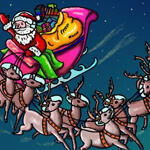
Here are some helpful hints for a healthy and safe holiday season from the Health Science Center.
No. 1: Holiday trees, holiday sneeze.
You could be whee-whee-wheezing instead of ho-ho-ing during the holidays if you don’t pick the right tree. Michael Vaughn, M.D., Ph.D., clinical associate professor in the department of medicine at the Health Science Center and head of the Alamo Asthma and Allergy Clinic in San Antonio, cautions those sensitive to pine trees to avoid purchasing a live tree for the home, or to consider buying an artificial tree. “Mountain cedar allergies are also prevalent from Dec. 15 through the end of January,” Dr. Vaughn said. “Symptoms can include headache, runny nose, sneezing, itchy, watery eyes and aches and pains. Although you may feel like you have the flu, illness from cedar allergies is rarely accompanied by a fever.”
No. 2: Fa-la-la-la food fiascos.
Food is everywhere during the holidays, but if you didn’t prepare the delightful dish or dessert, and you have specific food allergies, Dr. Vaughn suggests you ask the chef what went into making it. “Peanuts and other tree nuts are the main culprits for causing allergic reactions in adults,” Dr. Vaughn said. “Allergic reactions have been reported to occur after exposure to as little as 1/100 of a peanut. Symptoms may include swelling of the tongue, a flushed face, difficulty breathing, nausea, cramping or diarrhea. And that’s not how you want to spend your holidays.”
No. 3: Holiday heartburn.
To avoid heartburn, indigestion and other stomach problems, don’t overeat. Gastroenterologists such as Glenn Gross, M.D., clinical associate professor of medicine at the Health Science Center, advise those with more serious gastrointestinal disorders, including acid reflux disease, to be cautious when choosing what foods to eat at the holidays.
No. 4: A hot tree isn’t a happy tree.
If you place a natural tree right next to the stockings hung over the chimney with care, you’ll have a nice picture but also a safety issue.
“Make sure to position the tree far enough away from any heat source, including fireplaces, radiators and space heaters,” said Camerino Salazar, project coordinator with the Health Science Center’s South Texas Injury Prevention and Research Center (STIPRC). A dry tree is a fire hazard. The needles become brittle and prone to drop off, and the trunk is dry rather than sticky to the touch. Put water in the stand regularly. “According to national statistics, more than 400 residential fires involve Christmas trees each year,” Salazar said.

No. 5: Go light your world – properly.
You’re asking for trouble if you use outdoor lights indoors and indoor lights outdoors. “Always check the Underwriters Laboratory (UL) label,” Salazar said. Discard sets that have problems with sockets or wires. Extension cords should be placed next to walls to avoid tripping. Don’t plug more than three strings of lights into an extension cord. Be sure to turn off the lights on your tree before leaving the house or going to bed.
No. 6: Living hand to mouth.
If you have a child under 3, you know that everything goes into the mouth. “A string of popcorn hung on the lower reaches of the tree is very inviting to a baby or young toddler,” said Glen Medellin, M.D., assistant professor of pediatrics at the Health Science Center. Keep small and breakable ornaments out of reach, too. In decorations such as manger scenes or holly with candles, be alert for any small part that could cause choking.
No. 7: Don’t toy around with the wrong toys.
Buy toys that are appropriate for your child’s development. Toys with small parts that can cause choking should never be given to a child under 3. Teach older children to keep their toys away from younger brothers and sisters. “Marbles and other games look innocent enough, but are dangerous for young children,” Dr. Medellin said. “Also, avoid toys that can be pulled apart easily, revealing jagged edges and small pieces.”
No. 8: Don’t drive your sleigh after consuming alcohol.
“Plan to get home another way,” Salazar said. “Take a taxi, take a bus, or agree on a designated driver. If you have children, remind yourself that if you are in a wreck because of drinking, they are in the same wreck with the same danger. What a sobering thought.” By the way, the San Antonio Police Department estimates 40 percent of traffic fatalities are alcohol-related.
No. 9: Blue Christmas.
Christmas is usually a time of celebration, but for some it is a time of despair. Mental health experts such as John Casada, M.D., Ph.D., assistant professor of psychiatry, say depression is prevalent during the holiday season, especially this year for survivors of Hurricane Katrina who may still be homeless or separated from loved ones. Watch for sleeplessness, crying and other signs that a loved one is depressed, and seek help immediately.

